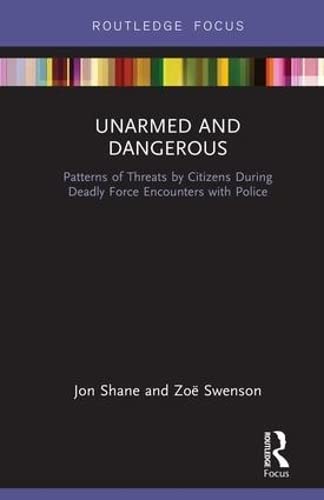Unarmed and Dangerous
Jon Shane and Zoë Swenson
74 pgs., Paperback $17.95; eBook $13.77
ISBN-13: 978-0367471385
Reviewed by Gila Hayes
There is a noteworthy absence of books, articles and scholarly studies about using deadly force to stop empty handed attacks. While recognizing similarities and differences between police and private citizens’ use of force allowances, I turned to this study of police use of force against “unarmed” offenders. Unarmed and Dangerous was introduced as intending, “to dispel the myth that unarmed offenders are not dangerous,” so I paid the fairly steep price for its 74 pages.
Co-authors Swenson and Shane observe that police are required “to act quickly and decisively to resolve conflict,” without time to ascertain the full extent of an “offender’s skill, ability, or intent when a threat materializes.” Public opinion will later draw conclusions based on a broader array of facts while the courts judge actions taken on what is known at the time. The US Constitution and case law requires that use of force be proportional and immediately necessary. When an officer is “forced to make split-second decisions about the type and amount of force necessary in a given situation,” complications can include the way humans perceive danger based on proximity and familiarity that might come from training or from experience. Additionally, as recognized in case law (Graham v. Connor 1989) offensive action is faster than defensive reaction, adding urgency to act preemptively before being shot, stabbed or struck.
Use of force decisions hinge on assessment of “the nature and imminence of the threat,” determined in real time from statements and actions of the offender. Swenson and Shane cite “hands in pockets or obscured from view, reaching around inside a vehicle or under a seat, agitation or nervousness, inconsistent or conflicting answers to questions, flight from the officer, uncooperativeness, physically charging or running toward the officer, assuming a fighting stance or a firing stance,” as factors contributing to a conclusion that attack is imminent.
Although framed in the context of officer-involved shootings, the concerns of armed citizens are mirrored. Public opinion and the media assume that an unarmed person is not dangerous when, “In fact, there is no data to support such a conclusion,” the authors write. They cite case law acknowledging that when assessing reasonableness of an officer’s actions, courts should consider an assailant’s fighting skill, drug or alcohol impairment, and “perceived physical strength.”
Those risks are confirmed by the 2015 FBI Uniform Crime Report, Law Enforcement Officer Killed and Assaulted (LEOKA), which reports “79.0% of assaults against officers occurred from ‘personal weapons’ (i.e., hands, fists, or feet), compared to firearms (4.0%), knives or other cutting instruments (1.8%), and other deadly weapons (15.1%). The same data also show that between 2006 and 2015, officers who sustained an injury from personal weapons steadily increased from 28.4% (2006) to 30.5% (2015).”
Beyond uniform crime reports which are stingy with details, little has been systematically recorded about deaths and injuries from empty-hand assaults. Swenson and Shane cite open source data compiled by the Washington Post analyzing police shootings of unarmed subjects between 2015 and 2016, plus two additional databases maintained online by activists concerned about law enforcement. One of the databases they cite is no longer accessible and the other is not sortable, so after reading the first two dozen incidents and finding that most were shot after first shooting at police, I moved on. Unarmed and Dangerous acknowledges that relying on crowd-sourced compilations of news reports is doubly unreliable – first, there is no oversight assuring incidents aren’t cherry picked and second, accuracy of the news reports is not assured. Law enforcement agencies don’t file standardized reports on shootings of unarmed assailants. Of the Washington Post reports, the authors note that the majority of the assaults analyzed involved empty hands (which they call physical weapons), accompanied by verbal threats or charging toward officers.
I was more interested in the study’s prioritization of risk from unarmed encounters. In the 112 police-involved shootings Swenson and Shane studied, empty-handed struggles with officers led the number of fatality shootings, followed in declining order by charging aggressively toward officers, disarms or attempted disarms and concealing hands when found committing a crime. Fewer were shot after they assumed a fighting stance or mimicked a shooting stance holding phones, pens, and other non-gun objects.
Swenson and Shane stress that the perception the attacker strives to convey through threatening words or mimicking reaching for or using a weapon contributes to reasonable perception that death or serious injury is imminent. “When a person is unarmed, or if a person simulates being armed with a weapon, then something more is generally required to justify an officer’s use of force. Ambiguous or equivocal physical gestures that are deliberately combined with threatening words or phrases will likely complete the impression that the person is armed and prepared to use the weapon regardless of whether the person is actually armed,” they write.
While I had hoped for less about how the statistics were developed and more detailed reporting about empty-hand attacks stopped by police using deadly force, Unarmed and Dangerous did outline when it is legal to use deadly force in response to physical force, and provided a wealth of links to other studies and to case law citations to illuminate factors that justify deadly force.
